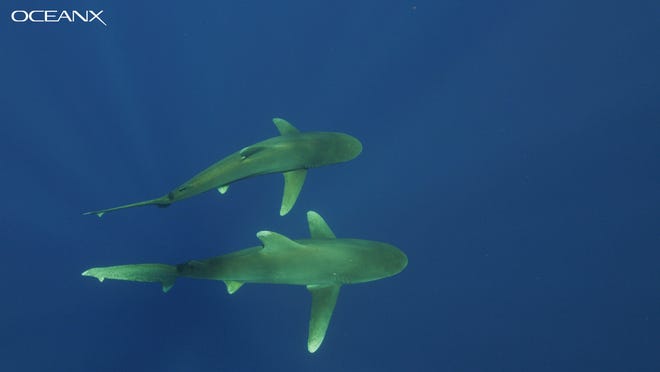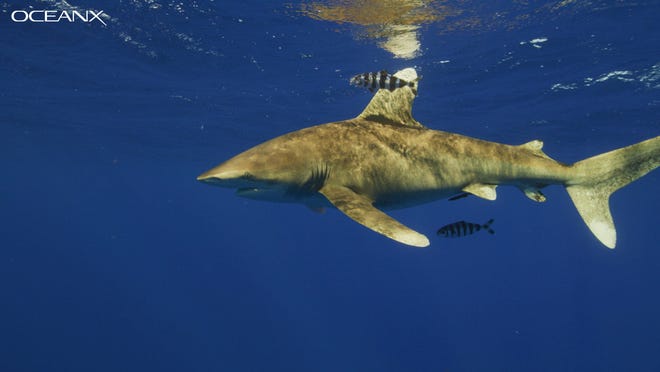'Something different': Rare video shows courtship ritual of threatened sharks
Brendan Talwar and a research team were studying oceanic whitetip sharks off the Bahamas when they were surprised to see a pair of courting sharks glide gracefully under the boat in unison.
Members of the crew jumped into the water to capture the pair on video as the male shark tried to woo the female close enough to sink his teeth into her flank so they could mate.
“It was very obvious they were doing something different than we’d ever seen,” said Talwar, a postdoctoral scholar at the Scripps Institution of Oceanography at University of California, San Diego. “The male was following the female so closely, mirroring every tail beat.”
NEWS:Spring ocean temperatures are shockingly hot around the globe. Scientists aren’t sure what happens next.
FOR SUBSCRIBERS:More hungry whales are flocking to ship-infested waters. It's a tragic vicious cycle near NYC.
The 25-minute video taken that day in July 2019 from the OceanX research vessel the Alucia is the first to capture the mating ritual on camera, researchers said. It became a central focus of a new study published in the journal Endangered Species Research.
The study sums up nearly a decade of work by a group of marine research institutions between 2011 and 2019 to try to unravel why oceanic whitetip sharks aggregate in the waters off Cat Island in the Bahamas. The scientists believe the whitetip sharks may be mating in the area during the summer but they say more research is needed to answer questions about when and where the elusive animals mate and give birth.

Shark populations threatened by extinction
Sharks around the globe have experienced dramatic declines of up to 70% since the 1970s as a result of commercial fishing and a worldwide trade in shark fin products, found an international study published in the journal Nature in 2021. The Nature study reported at least half of the world's shark species are threatened by extinction, including the oceanic whitetip.
The shark is listed as critically endangered on the International Union for Conservation of Nature Red List. The U.S. government listed the oceanic whitetip as threatened in 2018 and is finalizing a recovery plan.
As the name suggests, whitetips have mottled white markings on the tips of their fins and live in deep water offshore in the world's tropical and subtropical oceans.
Protecting species:Sharks and other species get new protections
Shark numbers in 'alarming' decline:Many species worldwide face extinction, study says
In the Bahamas, the sharks have greatly benefited from protective measures adopted by the government, including the banning of long-line fishing in 1993 and a ban on shark fishing and shark trade in 2011, Talwar said.
COVID and permitting issues with the Bahamian government halted their research after 2019, but the scientists hope it can be restarted, he said. They'd like to continue studying the sharks to gather conclusive results that could be used to help inform fishing regulations and recovery plans.
Oceanic whitetip shark facts
The sharks:
- Are a highly migratory species in the open ocean
- Constantly move long distances to find prey
- Often live an estimated 25 years, but may live up to 36
- Give birth to an average of 6 live pups

Searching for answers about pregnant sharks
Jim Gelsleichter, a biology professor at the University of North Florida, joined the research project with the Cape Eleuthera Institute and others in 2012 because of his team’s experience in shark tagging and using ultrasounds to study pregnancy in sharks.
The research team caught sharks with a single hook, letting the animal tire itself out, then bringing it over to the boat. They moved as quickly as possible within a few minutes to do the needed tests and ultrasounds before releasing the shark.
The ultrasounds showed many of the female sharks off Cat Island in April and May were pregnant. Gelsleichter said the work also showed that some portion of the females may be reproducing annually, even though previous research suggested oceanic whitetip sharks may only give birth every other year. That would be good news, because the species population could recover more quickly.
Pregnant shark found dead:Great hammerhead shark on Alabama beach had 40 unborn pups
Learning more about courtship and mating
Although most of the sharks caught were females, the few males they examined provided valuable information, Gelsleichter said, because the reproductive season can be tracked in the fluctuating testosterone levels of male sharks.
Male whitetips off Cat Island had lower testosterone levels in July compared to sharks caught in April and May, he said. Combined with other evidence, the research suggested mating might be taking place off Cat Island during the summer
They also documented other mating behaviors such as parallel swimming, following, shielding, nosing and biting. Their chance video encounter was the only time they documented the courtship behavior called "circle-back," where the male circles around behind the female, possibly to investigate clues from her scent in the water.
“It’s rare that people see that happen in any kind of shark, but especially the ones that live far offshore that have gone through these big population declines," Talwar said.
Ultimately however, the videographers were never able to see if the male shark was successful in his pursuit.
Dig Deeper
- How many bones do sharks have?:What to know about the elasmobranch
- Breton makes his annual return:1,500 pound great white shark returns to North Carolina
- Drone video:Reveals shark fests, though US bites remain rare
Dinah Voyles Pulver covers climate, environment and weather issues for USA
No comments: